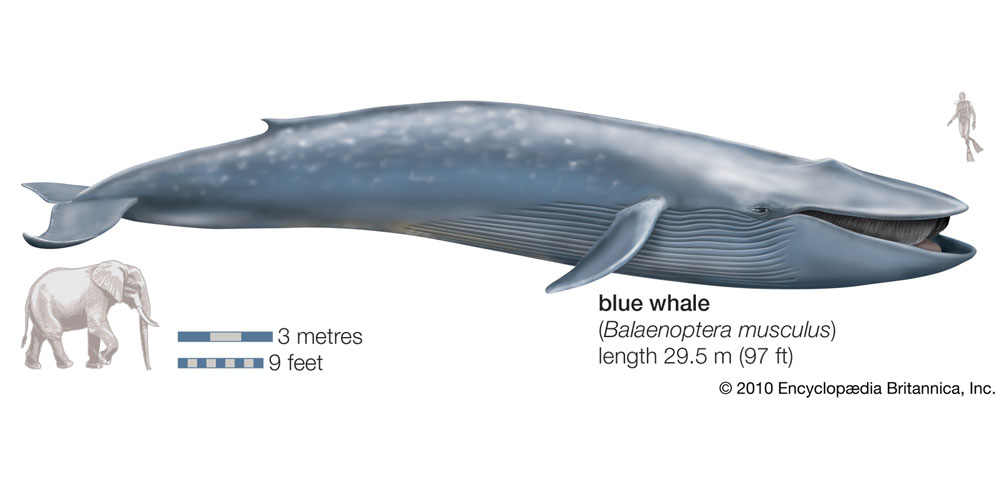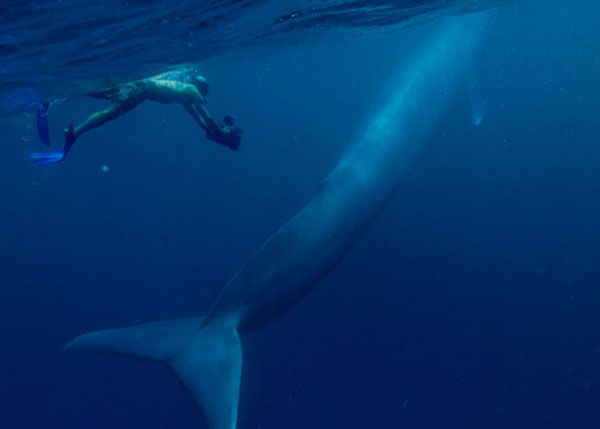A blue whale, the biggest animal in the world, can be spotted very near the area where we make our boat trips from Corralejo.
Some time ago, the Strait of “La Bocaina” which separates Fuerteventura and Lanzarote a blue whale was seen, by a group of investigators. This sighting took place during the campaign for the project development “Canarias con la Mar”, funded by “Fundación Biodiversidad”, the ministry of Environment (MAGRAMA), the Canary Island Government and Fuerteventura Council.

This cetacean (in latin, Balaenopteridaees) is one of the biggest animals in the world (the biggest dinosaur ever known was smaller that this whale). They can be up to 31m long and weigh a bit over 150 tons. The specimens in the southern hemisphere are usually bigger that those in the northern one. Female specimens (so as to give birth to their huge calves)are usually bigger than male ones too (maximum 24m long and 80 tons). They can reach a depth of 500m. Their usual speed is 22km/h, although they can even reach the 50km/h if they feel threatened, and they can also lower their speed up to 6.5 km/h when they forage for food.
With a long body and a wide head, this impressive whale has no teeth, but beard (around 300-400 formations on each side of their jaws, looking like toothbrushes, ideal to catch little preys (up to 1m long).
They can be submerged for 10-20 minutes, needing to go to the surface and breath after this time, bursting the typical jet of water of this species, which can reach the 6-12 ms high, imagine how big they are!
Surprisingly, these huge animals feed on small crustaceans; krills are they favourite food. Every specimen can eat up to 40 million of these crustaceans during their feeding stage, and they need up to 1.5 million calories a day to keep active.
The northern Pacific and Atlantic Oceans hold the biggest populations of these cetaceans. They are a really damaged species due to the whales hunting, and in many areas they have not recovered yet. Just one out of the four different species of blue whales in the world inhabits the northern Atlantic, which is why the fact of having caught sight of one of them in our waters is a true privilege. We are looking forward to finding this blue whale in our boat trips from Corralejo.
As far as their behaviour is concerned, blue whales have been seen alone, in couple or in small groups, no bigger than 7 specimens. When the food is abundant and on very few occasions, 60 of these animals have been seen together. They usually forage 100ms deep during the day, and they only go up to the surface at night. They feed through a filtering system: they open their mouth swallowing a large amount of water and krill. Then they close their jaws and push the water back outside through their beards, their preys being trapped there; with this system they also consume little fish, crustaceans and the squids which swim among the krill.
As for their breeding, their gestation period lasts around one year, and they reach their sexual maturity at the age of 10. They give birth to a single whale calf every 3 years. Whale calves are born in winter, in warm waters, and they are able to migrate thousands of kilometres until they reach polar waters to forage the next summer. Whale calves are usually 7mts long and weigh up to 3 tons; for 8 months they are breastfed, almost 400 litres of milk a day, and they grow up to 90kg a day, so when they get to their weaning process the calves have probably doubled their size already.
They have a long life expectancy, 90 years on average, although they can live up to 110 years.
These huge mammals make a deep vibrating sound that can be heard hundreds of kilometres away under the water. Little is known about the reason why they make this kind of sound, but these blue whales can make calls lasting between 10 and 30 seconds.
The blue whale is an endangered species for several reasons: many specimens die because they are hurt by big ships or because they are trapped in fishing nets. Of course, the global heating also affects the species they feed on. Nowadays whale hunting is punished in every continent, although illegal hunting still exists. It’s important to protect the areas of concentration of this species and their migratory corridors. Their presence in Fuerteventura and Lanzarote reminds us how important this area is.
We are looking forward to watching this blue whale, who has been named Esperanza, more closely in our boat trips from Corralejo. We’ll keep you informed.

FuerteCharter’s team.
Características de la ballena azul
Este cetáceo de la familia de los Rorcuales azules (en latín: Balaenopteridaees) es uno de los animales más grandes de la tierra (el dinosaurio más grande conocido es más pequeño que estas ballenas). Llegan a medir 31m de longitud y pesan poco más de 150 toneladas. Los ejemplares que habitan el hemisferio sur son generalmente de mayor tamaño que las del hemisferio norte; suelen ser más grandes las hembras (para poder parir sus enormes crías) que los machos (un máximo de 24m y 80 toneladas). Pueden llegar a profundidades de 500 metros. Normalmente se desplazan a 22 km/h, aunque si perciben alguna amenaza pueden alcanzar hasta 50 km/h, llegando a bajar esa velocidad hasta los 6.5 km/h cuando se alimentan.
De cuerpo alargado y cabeza ancha, este impresionante rorcual no tiene dientes, sino barbas, unos 300-400 formaciones en cada lado de su mandíbula, parecidas a las cerdas de un cepillo, ideales para capturar presas pequeñas y que pueden medir hasta 1 metro.
Puede permanecer bajo el agua por periodos de 10 a 20 minutos, saliendo a respirar después de este tiempo a la superficie, lanzando el chorro característico de esta especie, que puede llegar a alturas de 6 a 12 metros, ¡imagínense las dimensiones!
Alimentación de la ballena azul
Sorprendentemente la alimentación de estos impresionantes animales se basa en crustáceos muy pequeños; el krill es su sustento favorito. Cada individuo puede comer hasta 40 millones de estos crustáceos diarios en su época de alimentación, y necesitan alrededor de 1.5 millones de calorías al día para mantenerse activos.
Los océanos Pacífico Norte y Antártico Norte, albergan las poblaciones más grandes de estos cetáceos. Se trata de una especie muy dañada por la caza de ballenas y en muchas zonas aún no se ha recuperado. De las 4 subespecies de estos rorcuales azules que hay en el mundo, solo una habita en el Atlántico Norte, y se estima que no hay más de 400 individuos en nuestra zona del Atlántico, con lo que haber avistado una en nuestras aguas es todo un privilegio. Estamos deseando encontrarnos con esta ballena azul en nuestras excursiones en barco desde Corralejo.
Comportamiento de la ballena azul
En cuanto a su comportamiento se han avistado ballenas azules en solitario, en pareja o en grupos pequeños de no más de 7 individuos. Cuando hay gran cantidad de alimento, y en situaciones contadas, se han llegado a ver hasta 60 de estos animales juntos. Generalmente se alimentan a más de 100 m de profundidad durante el día y solo en la noche en la superficie. Su alimentación es por un sistema de filtrado: abre su boca introduciendo gran cantidad de agua y de krill, entonces cierra sus mandíbulas y empuja el agua de vuelta hacia fuera a través de sus barbas, quedando sus presas atrapadas; con este sistema accidentalmente consume también pequeños peces, crustáceos y calamares que nadan entre el krill.
Reproducción y crías de la ballena azul
En cuanto a su reproducción, su periodo de gestación dura alrededor de un año, y su madurez sexual llega aproximadamente a sus 10 años. Dan a luz una sola cría cada 3 años. Los ballenatos nacen en invierno en aguas cálidas con la capacidad de realizar una migración de miles de kilómetros hasta aguas polares donde alimentarse el siguiente verano. Las crías, al nacer, miden unos 7 metros de longitud y pesan hasta tres toneladas; durante 8 meses se alimentan de leche materna, casi 400 litros al día, creciendo diariamente hasta 90 kg más, con lo que cuando les llega el destete probablemente la cría ya ha doblado su tamaño.
Tienen una larga esperanza de vida, una media de 90 años, aunque pueden vivir incluso hasta los 110 años.
El Canto de la balleza azul
Estos grandes animales emiten un sonido profundo y resonante que se puede captar a cientos de kilómetros bajo las aguas. No se sabe mucho sobre los motivos que les llevan a producir estos cantos, pero todos los grupos de rorcuales azules emiten llamadas de al menos entre 10 y 30 segundos de duración.
La ballena azul es una especie en peligro de extinción por varios motivos, muchos ejemplares mueren por heridas realizadas por grandes buques o por quedar atrapados en redes de pesca. Por supuesto, el calentamiento global afecta a las especies de las que se alimenta. Actualmente la caza de ballenas está penada en cualquier continente, aunque sigue habiendo caza ilegal. Es importante proteger las zonas de concentración de la especie y sus corredores migratorios. Su presencia en la zona de Fuerteventura y Lanzarote nos vuelve a recordar la importancia de esta zona.

Deseando estamos ver más de cerca a esta ballena azul, a la que se ha llamado Esperanza, en nuestras excursiones desde Corralejo. Les mantendremos informados.
Equipo de FuerteCharter

